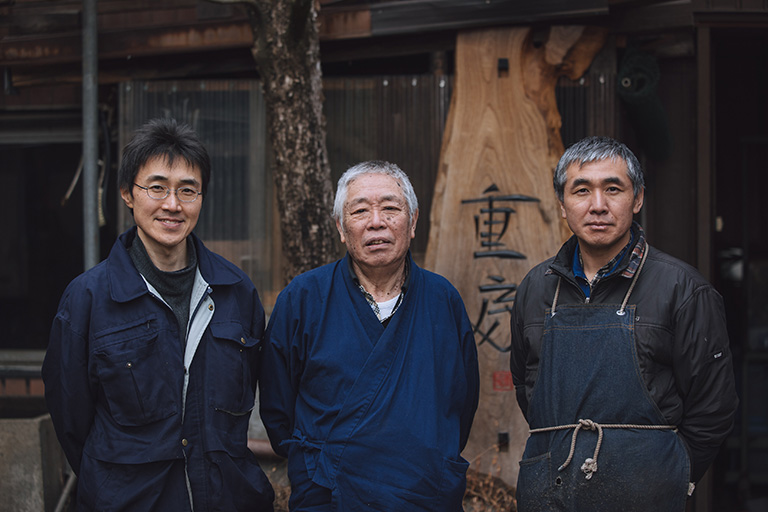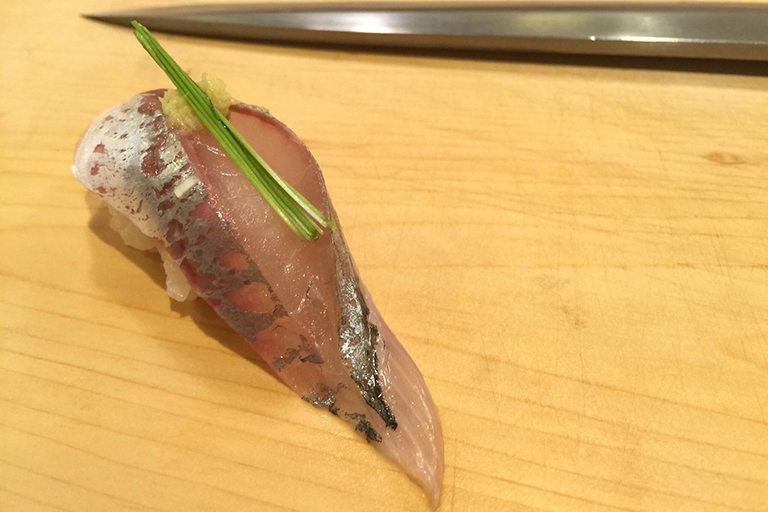Tsubame Sanjo is home to Japan’s master blacksmiths, where generations of craftsmen have shaped steel into some of the world’s most sought after sushi knives.
In Sanjo, old meets new as traditional steel-smithing techniques combine with modern technology to create some of the sharpest blades in the world. Two hours away from Tokyo via bullet train, Sanjo has been a centre of blacksmithing in Japan since the feudal Edo Period, and continues to celebrate its centuries-old manufacturing heritage with an annual factory festival.
Sanjo has good reason to be proud. The intricately carved blades produced in the area are prized for their strength and durability. Steel objects forged in Sanjo are used by top chefs around the world in the foremost sushi restaurants and even as the cutlery at the annual Nobel Prize ceremony dinner.
A tradition of excellence
The secret to Sanjo’s success and reputation for master-quality craftsmanship lies in a reverence for perfection in even the smallest of details. Dr. Koshi Yamamura is the third-generation President of Yamamura Manufacturing, founded by his grandfather in 1948.
“Our blacksmiths don’t just shape objects out of steel, we consider the very microstructure of the steel to create our blades,” he says, “The microstructure swells at high temperatures, so we forge steel using the lowest possible temperature to maximise the durability of our blades. If we were manufacturing factory equipment, we would use a different temperature.”
“The quality of a Japanese knife lies in its hardness and strength. Ideally, it’s unbreakable, unbendable, and unchippable, but these qualities conflict with one another.”
Tokifusa Iizuka, Master Blacksmith, Shigefusa Knives
This specialisation is crucial to meet the demands of the area’s blacksmiths. The efficacy of their techniques is dependent on the specific type and quality of steel used. Most Japanese traditional steel-working requires carbon content at 1%, with any other ratio being unusable. This preference dates back to when Japan was isolated from the rest of the world. Being in a country without many mineral resources, Japanese blacksmiths needed to ensure they used what little they had without wasting material.
“Different metals, including steel, have different properties and uses. Craftsmen apply their expertise to bring out the best in their chosen source material,” Yamamura says. For blade crafting, Yamamura uses locally-sourced high-carbon steel that has been specifically formulated for making sharp blades. “The ability of steel to adapt to multiple use cases is fascinating. Steel is special in its ability to be optimised for the qualities we need, such as rust-resistance. ”
Koshi Yamamura stands in front of rows of scissors and sushi knives
Sushi knives on display
Honing skill to the highest levels
It takes decades of experience for a craftsmen to reach the level where they can craft the steel to unlock its fullest potential. Tokifusa Iizuka has been making knives in Sanjo for 50 years. His Shigefusa Knives imprint is a local legend. In 2007, Iizuka’s high profile led him to receive an accolade from the governor of Niigata Prefecture, declaring him to be a master craftsman.
“It only takes a few years to learn how to craft a basic knife out of steel,” he says, “However, perfecting your ability to the level that you can do business takes at least a decade.”
Shigefusa knives are highly sought after by chefs all across the globe for their durability and razor-sharp edges. Each knife is hand-forged by the master Iizuka and his two sons. A single knife can take an entire day’s work from start to finish. There is a long waiting list to obtain one of these handcrafted knives, and some customers wait over three years for their knife to be completed.
“Our blacksmiths don’t just shape objects out of steel, we consider the very microstructure of the steel to create our blades.”
Koshi Yamamura, President, Yamamura Manufacturing
“The quality of a Japanese knife lies in its hardness and strength,” he says, “Ideally, it’s unbreakable, unbendable, and unchippable, but these qualities conflict with one another. So it’s important to constantly make adjustments during the forging process.”
Knowing how to bring these qualities out of the steel and adjust them at a fine level is something that can only be gained through first-hand experience. According to Iizuka, it cannot be taught.
“If I told my sons to do it this way or that way, they might be able to do an adequate job, but they would never be able to become masters in their own right,” says Iizuka. Long hours of hard work, trial and error, and facing one’s own mistakes head-on, he says, are necessary parts of the path to becoming a master.
“When I first started, I would fight with the steel and try to make it listen to me,” he says, “But as I have grown older, I now want to build a friendship with the steel as I craft it.
 Master Blacksmith Tokifusa Iizuka and his two sons craft all Shigefusa sushi knives
Master Blacksmith Tokifusa Iizuka and his two sons craft all Shigefusa sushi knives
Forging a relationship with the steel itself
Traditionally made Japanese knives, if maintained properly with regular sharpening, are made to last decades. This is only possible because they are created with steel, which is soft enough to sharpen, yet hard enough to endure decades of professional use.
Steel is the only metal that Iizuka works with. It is strong enough to make a blade that can’t be broken, yet malleable enough that it can be sharpened to create a super-fine edge. Striking this perfect balance is necessary to ensure that the knife can be properly maintained. This, according to Dr. Yamamura, is why a single Japanese steel knife can last a lifetime, or more.
“The quality of the steel must match the quality of the sharpening stone through a very finely struck balance,” says Dr. Yamamura. “Then the knife can last 10 years, 20 years, or even can be passed down to the next generation.”
This focus on perfection dates back to the origins of steel forging in Japan, when steel was used to craft katana swords used by feudal samurai. According to Japanese legend, the very souls of these warriors reside within their blade.
“Warriors in feudal Japan would call their sword tamashii, which means soul.” says Dr. Yamamura, “Our ancestors used the same techniques and the same materials as we do now, so today’s steel blades also contain the soul of the samurai.”
A blacksmith forging a sushi knife
Master Blacksmith Tokifusa Izuka sharpening a sushi knife
A master blacksmith places on of his sushi knives into a presentation box
Steel knives bring out the flavour in Japanese sushi
Japan’s sushi chefs depend on traditionally forged Japanese steel knives like Iizuka’s to prepare their finely cut fish. Sushi chef Katsunori Ikeda runs Sushi Katzu in central Tokyo, near the Hanzomon Gate of the Imperial Palace.
“The relationship between a chef and his knife is a deeply personal one,” says Ikeda. “Mine has been with me for 40 years.”
Sushi chefs traditionally use a trio of knives: yanagiba, deba, and usuba. The long, slender yanagiba culinary knife is used to slice the fish that will become sushi and sashimi. The large and heavy deba knife is used to fillet whole fish, and the usuba knife is used to prepare vegetables.
“There are scientific reasons why a super sharp Japanese blade makes a difference in preparing delicious sushi.”
Katsunori Ikeda, Sushi Chef
However, Ikeda is quick to mention that a good, trustworthy yanagiba can be used to accomplish all of the necessary tasks.
“With a single, well-made Japanese yanagiba steel knife,” says Ikeda, “I can fillet an entire 100-kilogramme maguro tuna fish from start to finish.”
But not just any knife will do. Japanese sushi chefs use traditionally forged steel knives because their blades are sharp enough to slice through flesh in a single motion.
“I was born the son of a sushi chef but I also always had a fascination with science,” says Ikeda, “There are scientific reasons why a super sharp Japanese blade makes a difference in preparing delicious sushi. A swift cut made in a single motion ensures that the delicate cell-structure of the fish itself is kept intact, so that the enzymes necessary to the fish’s distinctive taste and texture come out.
“I use a longer 33-centimetre yanagiba knife because of its long durability,” he explains, “Some people may think that sushi chefs need many knives to do their job, but I only use two.”
Masters like Ikeda cut by drawing the blade across the body of the fish in a distinctive pulling motion. Slicing in any other way creates friction that damages the texture of the fish.
“Some masters say that you cannot cut by trying to cut, you have to do it properly the first time, and every time,” he says with a glint in his eye, “That is what makes our Japanese steel knives special. These blades can slice cuts that are perfect every time, and respectable sushi cannot be served with anything less.”
 Incredibly sharp sushi knives allow for cuts that do not damage the delicate cellular structure of the fish
Incredibly sharp sushi knives allow for cuts that do not damage the delicate cellular structure of the fish
The future of Japanese knives
It is the traditional crafting techniques passed down by generations of masters like Iizuka that keep Sanjo’s tradition of excellence alive. But as Japan’s population shrinks, there is rising concern about how to cultivate the next generation of craftsmen.
This is part of the reason why Dr. Yamamura obtained his doctorate in engineering, making him a rare combination of craftsman and scholar.
“Our craftsmen have mastered traditional steel crafting techniques, but they are not necessarily able to explain the scientific basis behind them.” he says, “I wanted to be able to better connect our local community of craftsmen to the world.”
But what really keeps manufacturers like Yamamura focused on steel is something simple: It is fascinating to work with.
“Blacksmithing lets you do all the things your parents told you not to do when you were a kid, like working with fire and touching sharp objects,” he exclaims with a smile on his face. “As you craft the steel, you can see it change before your very eyes. This is something mesmerising that I would like everyone to see and experience for themselves.”